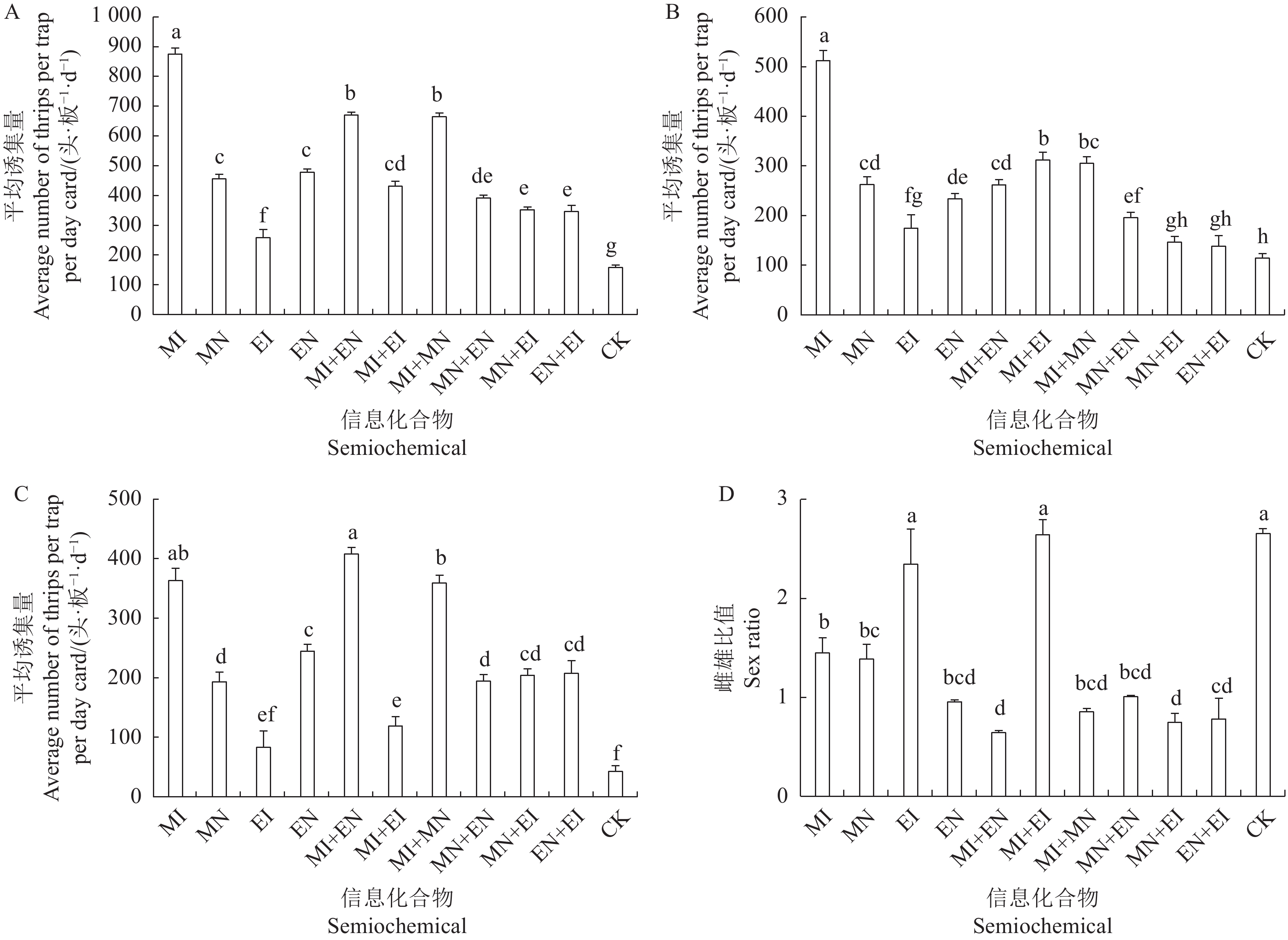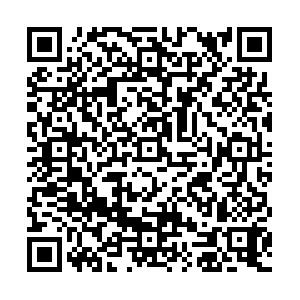Evaluation of Four Semiochemicals in the Trapping of Thrips hawaiiensis (Thysanoptera: Thripidae) and Beneficial Insects in Loquat Orchard
-
摘要:
目的 黄胸蓟马(Thrips hawaiiensis)是为害枇杷的重要害虫,本研究旨在明确单一色板、色板+单组分信息化合物和色板+双组分信息化合物对黄胸蓟马和有益昆虫的诱集作用,为枇杷园蓟马种群监测与防控及有益昆虫保护提供科学依据。 方法 通过田间试验比较3种颜色粘虫板(黄色、蓝色和白色)和悬挂高度(225 cm、150 cm、75 cm)对黄胸蓟马的诱集效果,在此基础上比较色板+单组分信息化合物(异烟酸甲酯、烟酸甲酯、异烟酸乙酯和烟酸乙酯)和色板+双组分信息化合物(异烟酸甲酯 +烟酸乙酯、异烟酸甲酯 +异烟酸乙酯、异烟酸甲酯 +烟酸甲酯、烟酸甲酯+烟酸乙酯、烟酸甲酯 +异烟酸乙酯、烟酸乙酯 +异烟酸乙酯)对黄胸蓟马和有益昆虫的诱集效果。 结果 白色粘虫板在悬挂高度150 cm对黄胸蓟马诱集数量显著高于其他处理组。单组分信息化合物异烟酸甲酯对黄胸蓟马引诱效果最强,诱集雌、雄成虫和黄胸蓟马总成虫数量分别为空白对照组的4.68倍、8.45倍和5.56倍;比较6种双组分信息化合物与对应单组分信息化合物对黄胸蓟马的诱捕效果,发现均对雌成虫呈拮抗作用。10种信息化合物处理组对有益昆虫食蚜蝇、寄生蜂类、草蛉、蜜蜂和胡蜂的诱集数量均较低,食蚜蝇诱集数量最多仅2.73头·板−1·d−1,各处理组益害比值均低于空白对照组,其中异烟酸甲酯处理组最小(1 : 285.33)。 结论 白色粘虫板与异烟酸甲酯组合对枇杷园花期黄胸蓟马的诱集效果最强,且对有益昆虫影响最小。 Abstract:Objective Thrips hawaiiensis is a significant loquat pest. This study aimed to determine the attractive effects of single-colored sticky traps, colored sticky traps + single semiochemical, and colored sticky traps + two semiochemicals on the capture of T. hawaiiensis and beneficial insects. These findings would provide a scientific basis for the monitoring and control of thrip populations, as well as the conservation of beneficial insects in loquat orchards. Method A field experiment was conducted to compare the effectiveness of sticky traps of three different colors (yellow, blue, white) hung aboveground at varied heights (225cm, 150cm, 75 cm) in attracting the target insects. Then, at the optimal sticky trap color and hanging height, four groups of traps coated with a single seimchemical (methyl isonicotinate, MI; methyl nicotinate, MN; ethyl isonicotinate, EI; ethyl nicotinate, EN) on each trap, six groups of traps with two seimchemicals (MI+EN, MI+EI, MI+MN, MN+EN, MN+EI, EN+EI) on each trap, and one control group were placed in the orchard to compare the attractant effects of T. hawaiiensis and beneficial insects. Result White sticky traps hung 150cm aboveground attracted the greatest number of thrips. The single methyl isonicotinate semiochemical (MIWT) was most effective in attracting T. hawaiiensis, and the numbers of female, male, and total T. hawaiiensis adult captured were 4.68 times, 8.45 times, and 5.56 times, respectively, that of the control. By comparing the trapping effects of the six two semiochemicals treatments and their corresponding single semiochemical on the capture of T. hawaiiensis adults showed that all of them had antagonistic effects on female adults. However, interestingly and importantly, the captured beneficial insects of the ten semiochemical treatments, such as hoverflies, parasitic wasps, lacewings, bees, and vespids, were all lower than those of the control, and the maximum number of hoverflies captured was only 2.73 thrips per trap per day, and the ratio of trapped beneficial insects : trapped thrips of all the treatments were lower than those of the control, with MIWT treatment showing the least (1:285.33). Conclusion In the loquat flowering season, the combination of the white sticky trap and methyl isonicotinate had the strongest trapping effect on T. hawaiiensis, with the least effect on beneficial insects. -
图 1 不同信息化合物对黄胸蓟马的诱集数量和雌雄性比
①MI、MN、EI、EN、MI+EN、MI+EI、MI+MN、MN+EN、MN+EI、EN+EI和CK分别表示异烟酸甲酯、烟酸甲酯、异烟酸乙酯、烟酸乙酯、异烟酸甲酯+烟酸乙酯、异烟酸甲酯+异烟酸乙酯、异烟酸甲酯+烟酸甲酯、烟酸甲酯+烟酸乙酯、烟酸甲酯+异烟酸乙酯、烟酸乙酯+异烟酸乙酯和空白对照。②柱形图数值表示平均数±标准误;柱上方不同小写字母表示差异显著(P<0.05)。③A:不同信息化合物对黄胸蓟马的总诱集数量;B:不同信息化合物对黄胸蓟马雌成虫的诱集数量;C:不同信息化合物对黄胸蓟马雄成虫的诱集数量;D:不同信息化合物对黄胸蓟马的雌雄性比。
Figure 1. Number and sex ratio of T.hawaiiensis caught by sticky traps coated with different semiochemicals
①MI: methyl isonicotinate; MN: methyl nicotinate; EI: ethyl isonicotinate; EN: ethyl nicotinate; and MI+EN, MI+EI, MI+MN, MN+EN, MN+EI, EN+EI, and CK are combinations paired with two semiochemicals and control.②Data with different lowercase letters on top of column indicate significant difference at 0.05 level.③A: total number of T.hawaiiensis caught on different traps; B: number of female T.hawaiiensis caught on different traps; C: number of male T.hawaiiensis caught on different traps; D: ratios of male/female T.hawaiiensis caught on different traps.
表 1 不同颜色粘虫板对黄胸蓟马的诱集数量和雌雄性比
Table 1. Number and sex ratio of T.hawaiiensis caught by differently colored sticky traps
粘虫板颜色
Colors黄胸蓟马 Thrips hawaiiensis/(头·板−1·d−1) 雌雄性比
Sex ratio总数
Total number雌成虫
Female adult雄成虫
Male adult黄色 32.00±1.19 c 22.93±1.21 c 9.07±0.61 c 2.59±0.28 b 蓝色 92.87±5.26 b 51.27±4.36 b 41.60±1.64 b 1.23±0.10 b 白色 215.33±5.37 a 157.80±6.01 a 57.53±1.20 a 2.75±0.15 a 表中数据为平均值±标准误。同列数据后不同的小写字母表示差异显著(P<0.05)。表2同。
Data are means ± SE; those with different lowercase letters on same column indicate significant difference among treatments at P<0.05. Same for Table 2.表 2 不同悬挂高度粘虫板对黄胸蓟马的诱集数量和雌雄性比
Table 2. Number and sex ratio of T.hawaiiensis caught by sticky traps hung at varied heights
高度
Height/cm黄胸蓟马 Thrips hawaiiensis /(头·板−1·d−1) 雌雄性比
Sex ratio总数
Total number雌成虫
Female adult雄成虫
Male adult255 221.93±4.23 b 154.60±4.44 b 67.33±1.57 a 2.30±0.10 b 150 266.20±1.17 a 194.47±1.28 a 71.73±0.92 a 2.71±0.05 a 75 158.00±2.20 c 103.73±3.03 c 54.27±2.65 b 1.94±0.14 c 表 3 不同信息化合物对枇杷园有益昆虫诱集数量和益害比
Table 3. Number and benefit/harm ratio of beneficial insects caught by sticky traps coated with different semiochemicals in loquat orchard
单位:(头·板−1·d−1) 信息化合物
Semiochemicals有益昆虫种类 Beneficial insect species 益害比
Benefit/harm ratio食蚜蝇
Hoverfly寄生蜂类
Parasitic wasp草蛉
Lacewing蜜蜂
Bee胡蜂
VespidMI 2.22±0.18 ab 0.04±0.03 a 0.02±0.02 ab 0.76±0.28 ab 0.02±0.02 b 1:285.33 MN 2.58±0.31 a 0.04±0.03 a 0.07±0.03 a 0.56±0.16 ab 0.00±0.00 b 1:140.42 EI 2.40±0.28 ab 0.07±0.03 a 0.02±0.02 ab 0.47±0.04 ab 0.02±0.02 b 1:86.50 EN 2.73±0.17 a 0.02±0.02 a 0.07±0.03 a 0.71±0.21 ab 0.02±0.02 b 1:134.63 MI+EN 1.60±0.29 b 0.07±0.07 a 0.00±0.00 b 1.27±0.50 a 0.00±0.00 b 1:228.51 MI+EI 2.56±0.25 a 0.00±0.00 a 0.02±0.02 ab 0.65±0.09 ab 0.04±0.03 ab 1:131.97 MI+MN 1.98±0.29 ab 0.04±0.03 a 0.00±0.00 b 0.71±0.29 ab 0.04±0.03 ab 1:238.94 MN+EN 2.73±0.34 a 0.00±0.00 a 0.00±0.00 b 0.80±0.20 ab 0.00±0.00 b 1:110.59 MN+EI 1.53±0.42 b 0.00±0.00 a 0.00±0.00 b 0.20±0.13 b 0.00±0.00 b 1:202.46 EN+EI 1.47±0.39 b 0.00±0.00 a 0.00±0.00 b 0.60±0.19 ab 0.13±0.08 a 1:157.39 CK 1.53±0.25 b 0.00±0.00 a 0.00±0.00 b 0.90±0.36 ab 0.07±0.04 ab 1:62.96 益害比是指每天每个粘虫板平均诱集有益昆虫数量与黄胸蓟马诱集数量的比值。
Benefit/harm ratio is averaged number of beneficial insects vs. that of T.hawaiiensis caught by a trap per day. -
[1] 蔡慧娟. 枇杷害虫与无公害综合防治技术 [J]. 福建农业科技, 2005(5):38−41. doi: 10.13651/j.cnki.fjnykj.2005.05.022CAI H J. Pest insect in loquat and its no pollution control [J]. Fujian Agricultural Science and Technology, 2005(5): 38−41.(in Chinese) doi: 10.13651/j.cnki.fjnykj.2005.05.022 [2] FU B L, LI Q, QIU H Y, et al. Resistance development, stability, cross-resistance potential, biological fitness and biochemical mechanisms of spinetoram resistance in Thrips hawaiiensis (Thysanoptera: Thripidae) [J]. Pest Management Science, 2018, 74(7): 1564−1574. doi: 10.1002/ps.4887 [3] ADESANYA A W, WATERS T D, LAVINE M D, et al. Multiple insecticide resistance in onion thrips populations from Western USA [J]. Pesticide Biochemistry and Physiology, 2020, 165: 104553. doi: 10.1016/j.pestbp.2020.104553 [4] WITZGALL P, KIRSCH P, CORK A. Sex pheromones and their impact on pest management [J]. Journal of Chemical Ecology, 2010, 36(1): 80−100. doi: 10.1007/s10886-009-9737-y [5] 陈俊谕, 牛黎明, 李磊, 等. 不同颜色粘虫板对花蓟马的田间诱集效果 [J]. 环境昆虫学报, 2017, 39(5):1169−1176.CHEN J Y, NIU L M, LI L, et al. Field trapping effect of different colors sticky cards to Frankliniella intonsa [J]. Journal of Environmental Entomology, 2017, 39(5): 1169−1176.(in Chinese) [6] 夏红军, 李建宇, 史梦竹, 等. 不同颜色诱虫板对芒果园蓟马的田间诱集效果 [J]. 福建农业学报, 2019, 34(7):818−823. doi: 10.19303/j.issn.1008-0384.2019.07.010XIA H J, LI J Y, SHI M Z, et al. Field trapping effect of different colors sticky cards to Thrips in mango orchard [J]. Fujian Journal of Agricultural Sciences, 2019, 34(7): 818−823.(in Chinese) doi: 10.19303/j.issn.1008-0384.2019.07.010 [7] MATTESON N A, TERRY L I. Response to color by male and female Frankliniella occidentalis during swarming and non-swarming behavior [J]. Entomologia Experimentalis et Applicata, 1992, 63(2): 187−201. doi: 10.1111/j.1570-7458.1992.tb01573.x [8] TEULON D A J, DAVIDSON M M, HEDDERLEY D I, et al. 4-pyridyl carbonyl and related compounds as thrips lures: Effectiveness for onion thrips and New Zealand flower thrips in field experiments [J]. Journal of Agricultural and Food Chemistry, 2007, 55(15): 6198−6205. doi: 10.1021/jf070389a [9] VAN TOL R W H M, DAVIDSON M M, BUTLER R C, et al. Visually and olfactorily enhanced attractive devices for thrips management [J]. Entomologia Experimentalis et Applicata, 2020, 168(9): 665−677. doi: 10.1111/eea.12969 [10] 李晓维, 程江辉, 韩海斌, 等. 植物次生代谢物质对蓟马的行为调控作用及其在蓟马防控中的应用 [J]. 昆虫学报, 2022, 65(9):1222−1246.LI X W, CHENG J H, HAN H B, et al. Behavioral manipulation of the plant secondary metabolites to thrips and their application in thrips management [J]. Acta Entomologica Sinica, 2022, 65(9): 1222−1246.(in Chinese) [11] MAO L G, CHANG Y M, YANG F L, et al. Attraction effect of different colored cards on Thrips Frankliniella intonsa in cowpea greenhouses in China [J]. Scientific Reports, 2018, 8(1): 13603. doi: 10.1038/s41598-018-32035-8 [12] HODDLE M S, ROBINSON L, MORGAN D. Attraction of thrips (Thysanoptera: Thripidae and Aeolothripidae) to colored sticky cards in a California avocado orchard [J]. Crop Protection, 2002, 21(5): 383−388. doi: 10.1016/S0261-2194(01)00119-3 [13] CHILDERS C C, BRECHT J K. Colored sticky traps for monitoring Frankliniella bispinosa (Morgan) (Thysanoptera: Thripidae) during flowering cycles in Citrus [J]. Journal of Economic Entomology, 1996, 89(5): 1240−1249. doi: 10.1093/jee/89.5.1240 [14] RAEN A Z, YE G Y, LU Z B, et al. Impact assessments of transgenic cry1Ab rice on the population dynamics of five non-target Thrips species and their general predatory flower bug in bt and non-bt rice fields using color sticky card traps [J]. Journal of Integrative Agriculture, 2013, 12(10): 1807−1815. doi: 10.1016/S2095-3119(13)60499-2 [15] RODRIGUEZ-SAONA C R, POLAVARAPU S, BARRY J D, et al. Color preference, seasonality, spatial distribution and species composition of thrips (Thysanoptera: Thripidae) in northern highbush blueberries [J]. Crop Protection, 2010, 29(11): 1331−1340. doi: 10.1016/j.cropro.2010.07.006 [16] TEULON D A J, PENMAN D R. Colour preferences of New Zealand thrips (Terebrantia: Thysanoptera) [J]. New Zealand Entomologist, 1992, 15(1): 8−13. doi: 10.1080/00779962.1992.9722621 [17] TEULON D A J, CASTAÉ C, NIELSEN M C, et al. Evaluation of new volatile compounds as lures for western flower thrips and onion thrips in New Zealand and Spain [J]. New Zealand Plant Protection, 2014, 67: 175−183. doi: 10.30843/nzpp.2014.67.5749 [18] TEULON D A J, DAVIDSON M M, PERRY N B, et al. Methyl isonicotinate—a non-pheromone thrips semiochemical—And its potential for pest management [J]. International Journal of Tropical Insect Science, 2017, 37(2): 50−56. doi: 10.1017/S1742758417000030 [19] WOGIN M J, BUTLER R C, TEULON D A J, et al. Field response of onion thrips and New Zealand flower thrips to single and binary blends of thrips lures [J]. The Canadian Entomologist, 2010, 142(1): 75−79. doi: 10.4039/n09-051 [20] TEULON D A J, NIELSEN M C, JAMES D E, et al. Combination of two odour chemical lures does not increase thrips capture in field bioassays [J]. New Zealand Plant Protection, 2007, 60: 61−66. doi: 10.30843/nzpp.2007.60.4610 [21] TIAN H J, CHEN Y X, CHEN Y, et al. A mixture of p-anisaldehyde and ethyl nicotinate elicits positive antennal and behavioral responses in Frankliniella occidentalis [J]. Entomologia Experimentalis et Applicata, 2022, 170(7): 603−611. doi: 10.1111/eea.13177 [22] TERRY L I, KELLY C K. Patterns of change in secondary and tertiary sex ratios of the Terebrantian Thrips, Frankliniella occidentalis [J]. Entomologia Experimentalis et Applicata, 1993, 66(3): 213−225. doi: 10.1111/j.1570-7458.1993.tb00712.x [23] DAVIDSON M M, NIELSEN M C, BUTLER R C, et al. Can semiochemicals attract both western flower thrips and their anthocorid predators? [J]. Entomologia Experimentalis et Applicata, 2015, 155(1): 54−63. doi: 10.1111/eea.12284 [24] MUVEA A M, WAIGANJO M M, KUTIMA H L, et al. Attraction of pest thrips (Thysanoptera: Thripidae) infesting French beans to coloured sticky traps with Lurem-TR and its utility for monitoring thrips populations [J]. International Journal of Tropical Insect Science, 2014, 34(3): 197−206. [25] WAITE M O. New strategies to improve the efficiency of the biological control agent, Orius insidiosus (Say), in greenhouse ornamental crops [D]. Canada: University of Guelph, 2012. [26] BROUGHTON S, HARRISON J. Evaluation of monitoring methods for thrips and the effect of trap colour and semiochemicals on sticky trap capture of thrips (Thysanoptera) And Beneficial Insects (Syrphidae, Hemerobiidae) in deciduous fruit trees in Western Australia [J]. Crop Protection, 2012, 42: 156−163. doi: 10.1016/j.cropro.2012.05.004 [27] SAMPSON C, KIRK W D J. Can mass trapping reduce thrips damage and is it economically viable? Management of the Western flower thrips in strawberry [J]. PLoS One, 2013, 8(11): e80787. doi: 10.1371/journal.pone.0080787 -








 下载:
下载:

